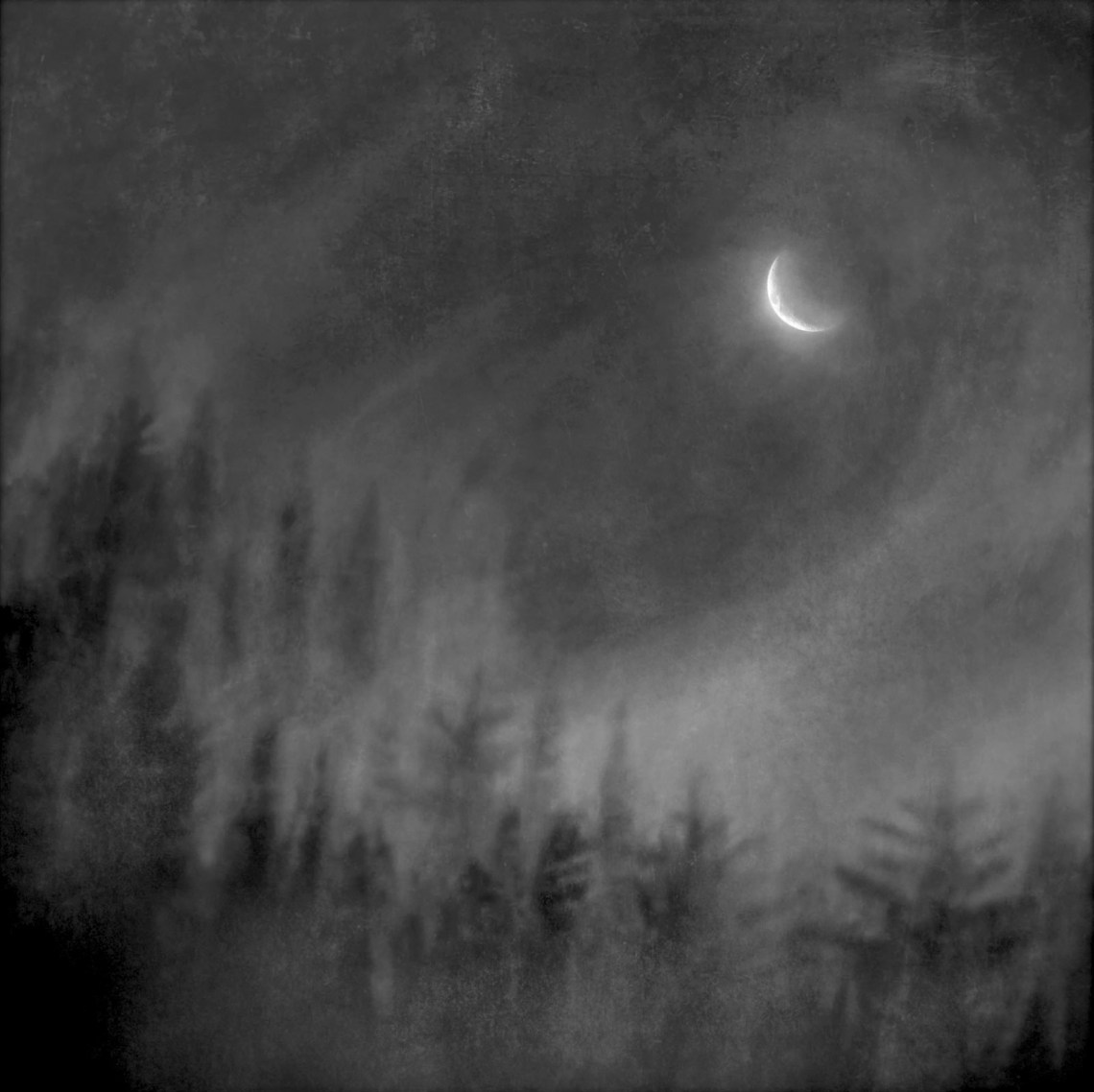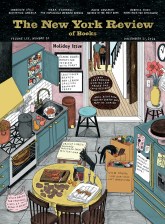Calvin and Hobbes ended, nearly thirty years ago, in white: snowfall has turned the woods into a “brand-new” world, as Hobbes puts it, “like…a big white sheet of paper to draw on!” The enormous final panel is half empty, with just a few bare trees in one corner, and Calvin and Hobbes rocketing off on a sled. “It’s a magical world,” Calvin famously declares. “Let’s go exploring!”
The Mysteries, Bill Watterson’s first book in the decades since he brought his masterpiece to a close—practically his first publicly released work, barring a few scattered images, cameos in other people’s comic strips, and a handful of essays—is hemmed in on all sides by black. It’s bound in black cloth, its images are bordered by it and filled with it, dense and gloomy, with just a few glimmers of white. It begins in another forest, but this one, we are told, is “dark and deep”: the opening image shows a swath of distant trees, a sliver of moon hanging above them, mist swirling through it all. This world is still magical, but exploring it is dangerous, even deadly—an adult’s act of hubris, not a child’s game.
Billed by the publishers as a “fable for grown-ups,” The Mysteries is structured like a picture book, slim and square, with a sentence or two on every left-hand page and a single image on the right. The words are spare and, especially at the beginning, seem simple. The time is “long ago,” and the people live in fear of “the Mysteries” that dwell in the woods, “shrouded in mists,” unseen but apparently “everywhere.” Stories are told of them, paintings painted of the sufferings they cause, walls built to keep them out. Finally, “the desperate King” sends his knights out into the forest to hunt down these Mysteries and bring them back.
The pictures provide much of the texture for this spartan narrative, presenting an unspecific hodgepodge Past that is at once evocative and faintly parodic. The knights, when they appear, are straightforwardly Arthurian, but the king looks more like a caricature of Henry VIII, fluffed up and heavily frilled, with a bulbous noggin and an incongruous waxed goatee. Medieval tapestries rub elbows with Tudor houses and some rather Renaissance-ish frescoes. On one page, a fearful peasant woman clutches several baguettes in what looks distinctly like a modern paper bag.
The images are, in a sense, the book’s first mystery. Watterson wrote the story himself but created the art with the caricaturist John Kascht, and the result looks like it’s by neither of them. It’s not even entirely clear how it was made. Kascht has said that they decided early on to “construct the art, rather than draw it”; Watterson, a little more gnomically, that “we were trying to make pictures that didn’t show things, for a story that didn’t say things.” Many of the figures are sculpted from clay (with swooping schnozzes and receding foreheads vaguely reminiscent of a few of Kascht’s drawings, if you squint), then photographed in front of painted backdrops, or collaged in with them. Some areas are detailed and finely modeled, with a smoothness that feels digitally manipulated; others are scratchy and roughly brushed, clearly handmade. Often the foreground is partially blurred, the edges a little faded, as if the whole scene had been captured in shallow focus by some antique camera.
Their ambiguous mix of modern and archaic adds to the sense that this is a story out of time, even as time within it rushes forward. Most of the knights the king sends out disappear, but eventually one Mystery is brought back and examined, and found to be “surprisingly ordinary”—though it is not otherwise described, and we readers are shown only the faces of villagers peering at it skeptically. More are captured, “each…even less impressive.” With boredom comes the modern world, if still a little unevenly distributed: tabloid headlines sneer “So what?” and “YAWN” in Gothic fonts; airplanes and overpasses appear; a wizard uses a wireless radio while taking notes with a quill; the king addresses his public on TV.
At this point the story might seem to be taking a familiar, gently humorous approach to the “adult fable,” a little ribbing about progress and disenchantment offering an opportunity for sight gags like the image of a beefy man in a ruff and puffed sleeves driving past an on-ramp, iced coffee in hand. (With the Mysteries dispelled, the text observes, people “were finally in control of everything,” and “lived luxuriously.”) But even here the art is too strange, too slippery to be laughed off, the narration a little too dour and foreboding. These rough-hewn humanoids in their odd assemblage of a world look like something out of the Quay Brothers—gentleness does not apply.
Advertisement
The most memorable images are the emptiest. It takes years for the knights to succeed in their mission, and it comes at a cost. One page announces, simply: “Many Knights were never seen again.” The accompanying illustration is stark, almost abstract: a few bare trees, their trunks shining white in the darkness, their reflections the only hint of a river between us and them. The pigment looks scratched on, the surface scabby and corroded, like a cave painting or the blank fields of drabness surrounding Goya’s Drowning Dog. (In 2011 Watterson contributed a painting of a character from Richard Thompson’s comic strip Cul de Sac to a charity auction; its abraded brushwork is clearly from the same hand that painted these trees, though it is far warmer and more colorful.) There’s no joke here, just the world at its most unyielding.
That’s where this story is headed. As humanity luxuriates in its power, the Mysteries reassert theirs. The sky changes, the ground “creaks and shudders,” “scouring winds” and “acrid smells” grow stronger, animals flee. “Rather late,” Watterson writes, “the people grew alarmed.” This is paired with a surprisingly peaceful image: the moon again, still a crescent, but larger now. The trees are gone. There’s just the hint of the horizon, some mist, and blackness and the scattered stars above. Our gaze has shifted upward, and it does not return.
Their alarm is the last we hear of the people, any people. The images become cosmic—the earth, the stars, the galaxy. An apocalypse seems to have happened somewhere in the margins. Our end is not even a whimper, just the turning of a page. “Time moved on,” Watterson tells us, and the book with it.
It’s a startlingly cold conclusion, and a bit of a puzzle. The most obvious way to read The Mysteries is as an environmental parable—“a nephew of Dr. Seuss’s The Lorax,” as Rivka Galchen put it in The New Yorker. Its middle pages do seem to be poking at scientific arrogance, and its apocalypse, as it approaches, does have some kinship with climate change: the creeping, multifaceted, inescapable wrongness, not to mention the belated response.
Yet the book’s careful indefiniteness, and its thorough bleakness, make that interpretation feel inadequate. There’s no sense that humanity could have really done anything about what happens. The slowness of their alarm is merely noted—“Rather late”—as if for the record, rather than blamed. The investigation of the Mysteries is, at most, only loosely related to technological advancement, and the Mysteries themselves are left so thoroughly mysterious that the target seems not so much pollution or technological presumption as the pursuit of knowledge itself, or progress in general—or perhaps just the idea of progress.
Some images seem to lament facts even more fundamental than our sickened weather. We are told, for instance, that, as their knowledge increased, the people “laughed at the old paintings” of the Mysteries. The illustration shows a modern museum, complete with woolgathering guard. We can see parts of a few paintings, by far the biggest and most detailed of which is of Death himself, unmistakable, wielding a sickle and riding a pale horse through the sky above a burning harbor town. The Lorax indicts his foes for grave crimes, but “laughing at death” is not one of them.
The emptiest image in the book, and possibly the saddest, comes at the beginning of the end. As the ravages of the Mysteries reach their peak, we are told, “more and more often, things disappeared.” Alongside this is a blurry, barely discernible landscape: gray sky, flat horizon, the only feature a distant dust cloud, or maybe a plume of smoke. One might think of wildfires, burning oil fields, bombed-out towns, poison gas, drought, or any of the other innumerable ways our worlds can disappear, but this unassimilable smudge is all we get.
By this point in the book, Watterson seems to be lamenting—or perhaps not even lamenting, merely observing—the bare fact of transience itself. “The people” can be fearful or cocky, can grow alarmed or not, can send their knights on dangerous quests, can build highways and airplanes, but all things eventually turn to dust and drift away. (All human things, that is: the Mysteries, of course, live “happily ever after.”)
Upon rereading, the shape, if not the story, of The Mysteries has a certain congruence with the arc of a life. It begins in ignorance; moves through exploration into confidence, mastery, jaded complacency; then bad news accumulates, uneasiness builds, and finally—late, too late—comes the realization that mastery was just ignorance in disguise. Then it ends, and the world does not.
Advertisement
Galchen speculates that Watterson ended Calvin and Hobbes because he at last “became O.K. with growing up,” with moving beyond the child’s “enchanted way of seeing” he had explored so beautifully for a decade. No artist owes the world their work, especially not Watterson, who has already provided readers with thousands of days of sly and anarchic wisdom. But I can’t help feeling a certain selfish regret at not being able to see what he might have come up with in the prime of his disenchantment. With The Mysteries we are already in the realm of late work—abrupt, discomfiting. Its wisdom is grand and chilly. And we can only guess at the long journey from Calvin’s woods to these.




